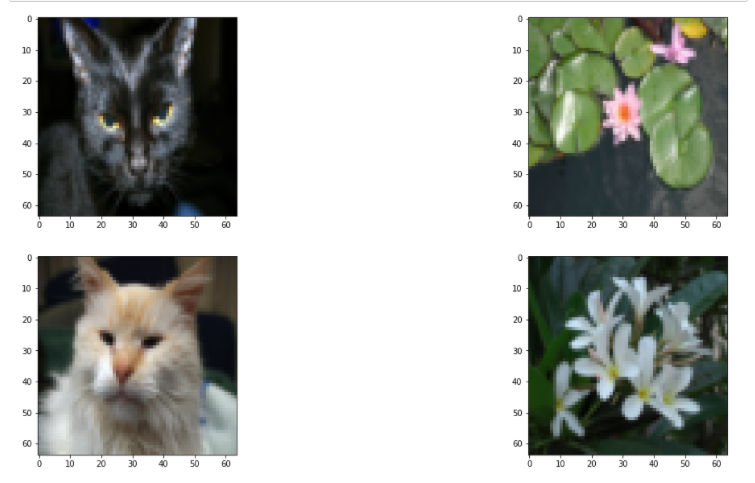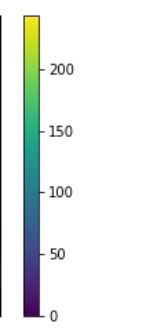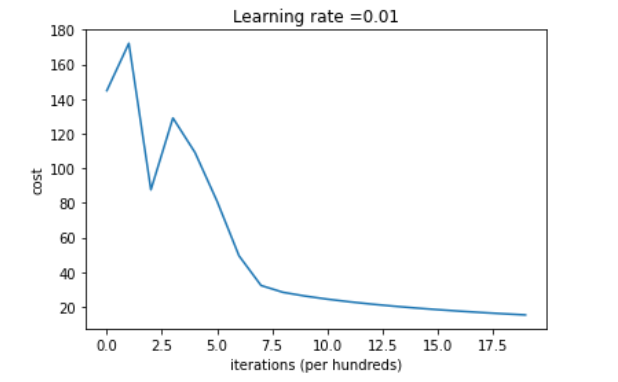Title Description
Given the training data set (pictures of cats), let's build a simple neural network to identify cats.
Dataset description
There are 209 pictures in the training set, and the shape of each picture is (64, 64, 3)
There are 50 pictures in the test set, and the shape of each picture is (64, 64, 3)
classes stores two string data in bytes, namely [b'non-cat ', b'cat']
The classification label is {0,1}. 0 means not a cat, 1 means a cat
Dataset Download
Github address: For reference only (including complete code and dataset resources)
code implementation
Construct load dataset function
The code for loading data sets has been given in Wu Enda's course
import numpy as np
import h5py
def load_dataset():
train_dataset = h5py.File('/datasets/train_catvnoncat.h5',', "r") # The relative path is given here. If the dataset file is under the currently written code file, it does not need to be modified. Otherwise, write the path corresponding to the specific dataset
train_set_x_orig = np.array(train_dataset["train_set_x"][:]) # your train set features
train_set_y_orig = np.array(train_dataset["train_set_y"][:]) # your train set labels
test_dataset = h5py.File(./datasets/test_catvnoncat.h5', "r")
test_set_x_orig = np.array(test_dataset["test_set_x"][:]) # your test set features
test_set_y_orig = np.array(test_dataset["test_set_y"][:]) # your test set labels
classes = np.array(test_dataset["list_classes"][:]) # the list of classes
train_set_y_orig = train_set_y_orig.reshape((1, train_set_y_orig.shape[0]))
test_set_y_orig = test_set_y_orig.reshape((1, test_set_y_orig.shape[0]))
# classes saves two string data in bytes, namely: [b'non-cat', b'cat']
return train_set_x_orig, train_set_y_orig, test_set_x_orig, test_set_y_orig, classes
Load dataset
x_train, y_train, x_test, y_test, classes = load_dataset()
Convert data to array format
X_train = np.array(x_train) Y_train = np.array(y_train) X_test = np.array(x_test) Y_test = np.array(y_test) print(X_train.shape) # The first dimension corresponds to the number of pictures, and the latter dimension corresponds to the shape of the picture print(X_test.shape)
View pictures in dataset
import matplotlib.pyplot as plt
index = (25, 26, 27, 28)
plt.subplots(figsize=(20, 10))
for i in range(4):
plt.subplot(2,2,i+1)
plt.imshow(x_train[index[i]])
Result:

Image array processing
In order to facilitate the prediction of data later, we reconstruct the array with dimension (64, 64, 3) into an array with dimension (64x64x3, 1)
x_train_flatten = x_train.reshape(x_train.shape[0], -1).T # Here. shape[]0] means to take the first dimension as the first dimension of the new array, and - 1 means to multiply the remaining dimensions into a new dimension x_test_flatten = x_test.reshape(x_test.shape[0], -1).T
View new array shapes
print(x_train_flatten.shape) print(x_test_flatten.shape)
Result:

Processing of picture data

We know that the pixel value is between 0 and 255. In order to center the later data processing, we will place the standardized data between [0, 1]
X_train = x_train_flatten / 255.0 X_test = x_test_flatten / 255.0
Gradient descent method for constructing logistic regression
sigmoid function
def sigmoid(z):
s = 1 / (1 + np.exp(-z))
return s
Initialize the function of w, b
def initialize_w_b(dim):
w = np.zeros(shape=(dim,1))
b = 0
assert(w.shape == (dim, 1))
assert(isinstance(b, float) or isinstance(b, int)) # It's OK not to write this here, but we should be more rigorous in order to standardize the code and avoid unnecessary errors
return (w, b)
def initialize_w_b(dim):
w = np.zeros(shape=(dim,1))
b = 0
assert(w.shape == (dim, 1))
assert(isinstance(b, float) or isinstance(b, int)) # It's OK not to write this here, but we should be more rigorous in order to standardize the code and avoid unnecessary errors
return (w, b)
Propagation function
def propagate(w, b, X, Y):
m = X.shape[1]
# Forward propagation
z = sigmoid(np.dot(w.T, X) + b)
# cost function
cost = (-1) * np.sum(Y * np.log(z) + (1 - Y) * (np.log(1 - z)))
# Back propagation
dw = (1 / m) * np.dot(X, (z- Y).T)
db = (1/ m) * np.sum(z - Y)
assert(dw.shape == w.shape)
assert(db.dtype == float)
cost = np.squeeze(cost) # Eliminate the value of 1 in the shape (i.e. dimension reduction)
assert(cost.shape == ())
# Dictionary storage dw, db
grads = {
'dw':dw,
'db':db
}
return (grads, cost)
Optimization function
def optimizer(w, b, X, Y, num_iterations, learning_rate,):
costs = []
for i in range (num_iterations):
grads, cost = propagate(w, b, X, Y)
dw = grads['dw']
db = grads['db']
# Update w, b
w = w - learning_rate * dw
b = b - learning_rate * db
if i % 100 == 0:
costs.append(cost) # Value of storage cost function
print("Number of iterations: i%,Error value:%f" % (i, cost))
params = {
'w':w,
'b':b
}
grads ={
'dw':dw,
'db':db
}
return (params, grads, costs)
In this way, we completed the gradient descent of simple logistic regression
Prediction function
During the prediction of the model, we may have values with tag values between (0,1). Therefore, we need to carry out the following processing
def predict(w, b, X):
m = X.shape[1] #Number of pictures
Y_prediction = np.zeros((1,m))
w = w.reshape(X.shape[0],1)
#Calculate and predict the probability of cats appearing in the picture
z = sigmoid(np.dot(w.T , X) + b)
for i in range(z.shape[1]):
#Convert the probability z [0, i] to the actual prediction p [0, i]
if z[0,i] > 0.5:
Y_prediction[0,i] = 1
else:
Y_prediction[0,i] = 0
#Use assertions
assert(Y_prediction.shape == (1,m)) # Ensure y_ Shape of prediction
return Y_prediction
We have completed all the functions we need, and finally write an integration function
Integration function
def model(X_train, Y_train, X_test, Y_test, num_iterations, learning_rate):
w , b = initialize_w_b(X_train.shape[0])
parameters , grads , costs = optimizer(w , b , X_train , Y_train,num_iterations , learning_rate)
#Retrieve parameters w and b from the dictionary parameters
w , b = parameters["w"] , parameters["b"]
#Predictive test / training set
Y_prediction_test = predict(w , b, X_test)
Y_prediction_train = predict(w , b, X_train)
#Print accuracy after training
print("Training set accuracy:" , format(100 - np.mean(np.abs(Y_prediction_train - Y_train)) * 100) ,"%")
print("Test set accuracy:" , format(100 - np.mean(np.abs(Y_prediction_test - Y_test)) * 100) ,"%")
stored = {
"costs" : costs,
"Y_prediction_test" : Y_prediction_test,
"Y_prediciton_train" : Y_prediction_train,
"w" : w,
"b" : b,
"learning_rate" : learning_rate,
"num_iterations" : num_iterations }
return stored
model training
d = model(X_train, y_train, X_test, y_test,num_iterations=2000, learning_rate=0.01)
Result:

View gradient descent learning
costs = np.squeeze(d['costs'])
plt.plot(costs)
plt.ylabel('cost')
plt.xlabel('iterations ( hundreds)')
plt.title("Learning rate =" + str(d["learning_rate"]))
plt.show()
Result:

I hope this article is helpful to everyone's study!